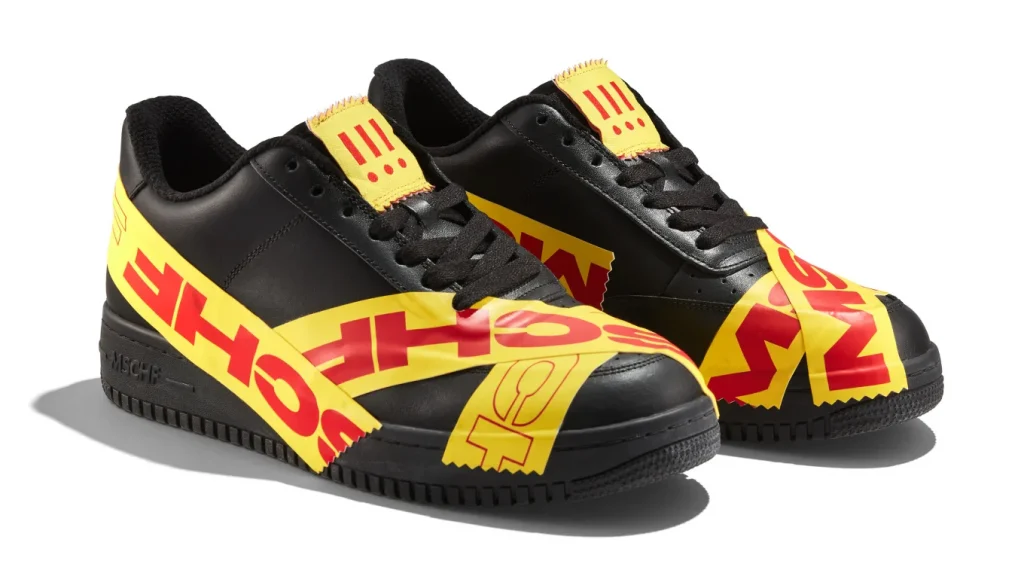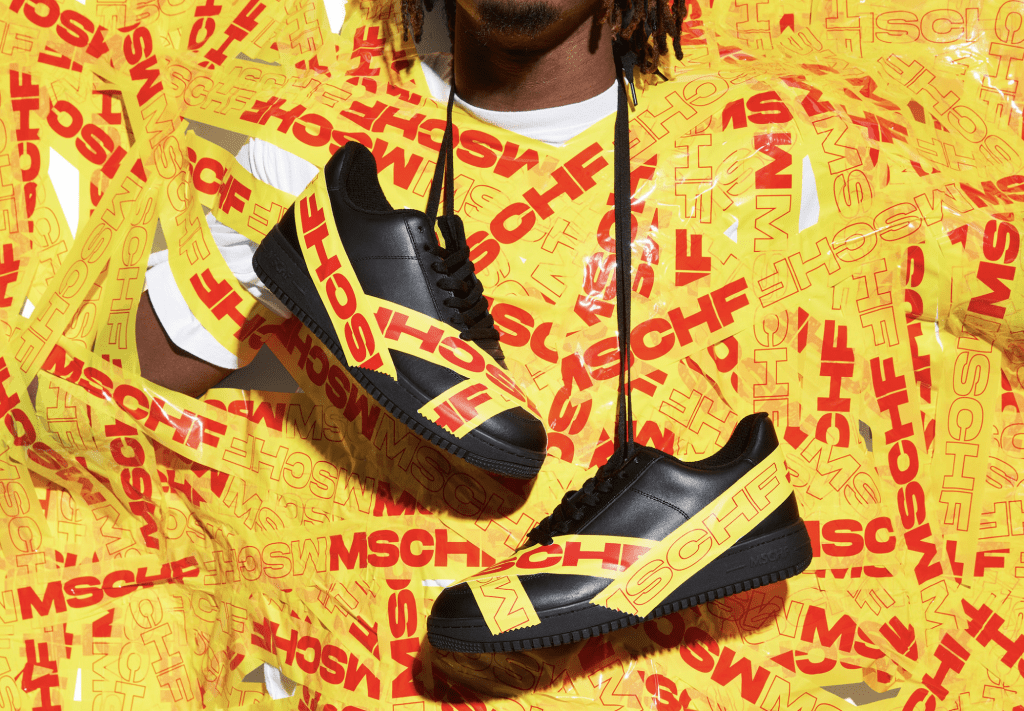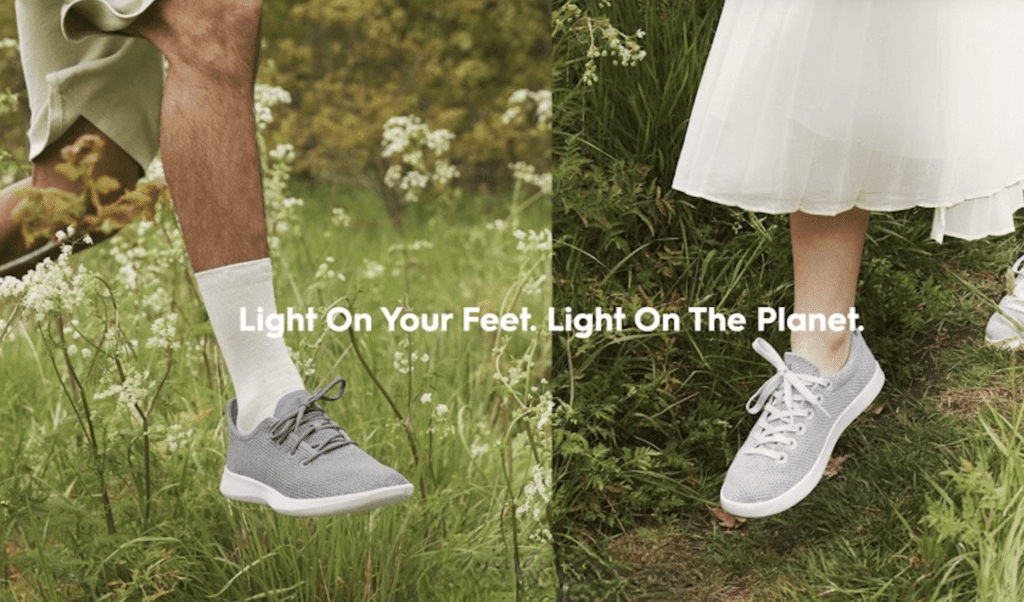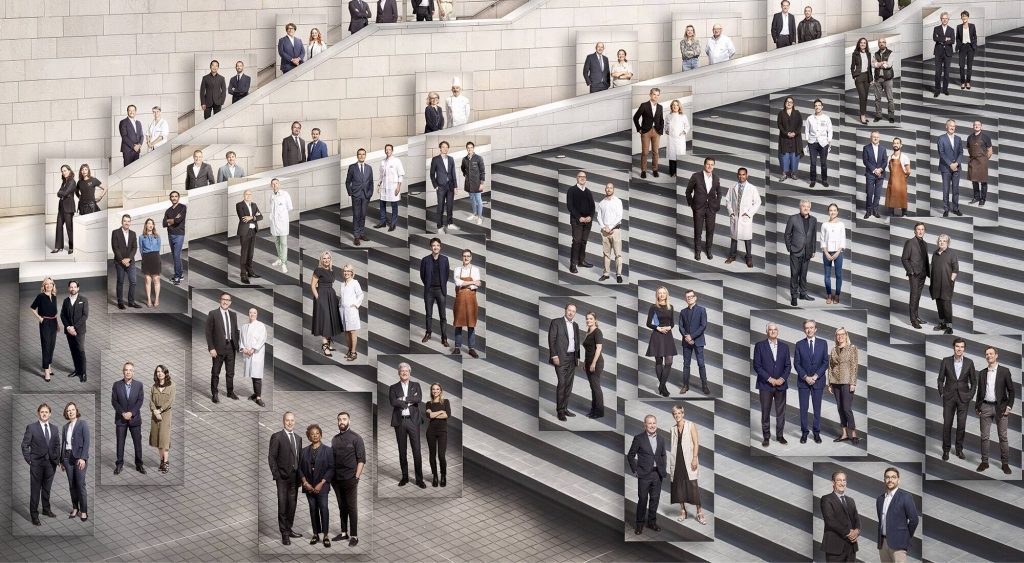MSCHF is getting into the sneaker game … again. Almost a year after landing on the receiving end of a trademark infringement and dilution lawsuit filed by Nike thanks to its heavily-publicized Satan Shoes and swiftly settling the matter, MSCHF announced the impending release of its Tap3 (pronounced “tape”) sneakers on Thursday. The Brooklyn, New York-based company describes its newest offering as “a winking riff on the image of an Air Force 1, with overmolded TPU tape over all the standard brand elements.” In an apparent attempt to distinguish this new offering from Nike’s footwear (presumably in nod to the legal pushback that it received in response to the Satan Shoes), MSCHF stated in a release this week that the new shoe was “constructed from the ground up, with our own designs from sole to insole to upper.”
Six-year-old MSCHF has made it clear in its tour-de-force of pre-launch media that it believes that the Tap3 sneakers – which are part of a larger sneaker-centric endeavor by the art collective-turned-brand – are above-board from a trademark perspective. But the sneakers and the larger launch of MSCHF Sneakers may not be as straightforward as they seem.
Primarily, there is the issue of whether the new Tap3 sneaker – which Complex described as “definitely not an all-black Air Force 1 even though … it looks rather like an all-black Air Force 1” and that the New York Times called “very reminiscent” of the Nike AF1 – infringes Nike’s trademark rights in the configuration of the AF1. This would turn on the rights that Nike claims in the AF1 design, which – if we are going by the elements that Nike asserts in its pending trademark claims against John Geiger – include the toe box, midsole, outsole, upper panel, and eyestay.

(Specifically, in the Geiger case, Nike argues that it rights in the elements that make up the AF1 sneaker are reflected in USPTO registrations no. 3,451,905, which covers “the design of the stitching on the exterior of the shoe, the design of the material panels that form the exterior body of the shoe, the design of the wavy panel on top of the shoe that encompasses the eyelets for the shoe laces, the design of the vertical ridge pattern on the sides of the sole of the shoe, and the relative position of these elements to each other;” and no. 5,820,374, which extends to a “3D configuration comprising the design of the vertical ridge pattern on the sides of the sole of the shoe, the repeating star pattern on the toe and heel of the sole of the shoe, and the relative position of these elements to each other.”)
“Many of these aspects of the [Nike AF1] sneaker were changed by MSCHF in the Tap3,” says Zak Kurtz, founder of the New York-based Sneaker Law Firm. He notes that “at first glance MSCHF’s Tap3 sneaker looks a whole lot like the silhouette of an all-black Nike AF1,” including the “the midsole on the Tap3 sneaker, [which] does look very similar to the AF1.” He cautions, however, that it the midsole, for instance, is “just one feature to consider and should not be given significantly more weight than the other features,” noting that an infringement analysis would consider “the overall look and feel of the sneaker as a whole.”
Another thing that MSCHF might have on its side in the event of an infringement claim from Nike? Fair use. It would not be surprising if MSCHF argued that Tap3 sneaker was a direct response to/commentary on the Satan Shoe case, or if it doubled down into the claim that it makes in the Tap3 press release, namely, that “the approximate shape of the AF1 has become the platonic ideal of a low top sneaker. The first thing every brand that’s trying to pivot into sneakers does is make a pseudo-AF1 with a star tipped lighting bolt, a flag, etc.,” which seems to push back against the distinctiveness of – and thus, Nike’s rights in – the AF1 design, which is one of the key points of contention in the Geiger case.
The potential for infringement is not the only legal issue that may be at play here, given the history between Nike and MSCHF, and the settlement that they entered into last year, which could certainly put restrictions on MSCHF that go further than the trademark rights that Nike maintains, including in the configurations of its footwear. If the terms of the confidential settlement agreement are sweeping and they very well might be, they could put limitation on how MSCHF operates in the footwear space, including in regards to competing with Nike. (MSCHF told the Wall Street Journal that the “nothing in the settlement prevents MSCHF from entering the sneaker market with its own designs.”)
Beyond that, the terms would almost certainly prevent MSCHF from offering up footwear and corresponding packaging that would be confusing to consumers, who – it is worth noting – would probably would not casual footwear buyers and would be a more sophisticated pool in this hypothetical case.

Still yet, it would not be surprising if the settlement includes confidentiality provisions that prevent MSCHF from publicly speaking about the resolution of the Satan Shoes case, which may or may not be breached by way of talk of the terms of the agreement – and/or language, such as the following, which the brand’s co-founder Daniel Greenberg, the chief creative officer Kevin Wiesner and the chief creative officer Lukas Bentel, collectively told the Times: “In the end, Nike says we did nothing wrong, and we say Nike did nothing wrong in suing us.” (If there is a non-disparagement provision, other interview blurbs might also ruffle some feathers for Nike.)
As for whether the company is concerned about running afoul of the agreement, MSCHF told TFL, “Like Nike, we’re mindful of the terms of the settlement.”
It will be interesting to see how this approach of “poking the bear,” which appears in many cases to deliberately court the potential for litigation, plays out as the company sets its sights on becoming a bona fide brand and scaling the volume of their operations. Should MSCHF really begin to move away from their one-and-done drops with an increasing focus on the footwear category, the company stands to chip away at the main defense that it set out in response to the Satan Shoes case: that its sneakers fall more within the realm of an “artistic and expressive” project than the world of purely commercial footwear. It is not yet clear if – or how – the company would straddle the line between expressive and commercial works; it is worth noting that decisions in cases like Bad Spaniels will likely make that easier. At the same time, if MSCHF does actually grow into a sizable footwear brand of sorts, it is not impossible to imagine investors eventually having concerns about its media-by-litigation approach. As of January 2020, MSCHF had raised $11.5 million, according to PitchBook.
Ultimately, and seemingly not giving up on their devil-may-care attitude, MSCHF revealed on Thursday that they have some collaboration shoes lined up, and they “will be appropriating some iconic sneaker forms,” suggesting that their days of earning media attention not by traditional advertising (which they eschew) but by way of threats of litigation or actual lawsuits is not going away.











